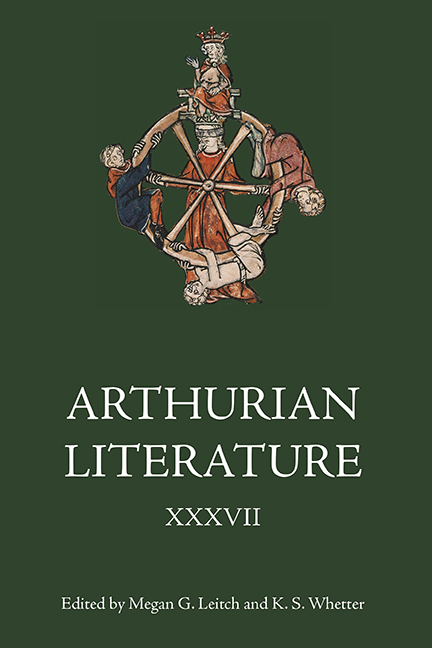Book contents
- Frontmatter
- Contents
- List of Charts and Tables
- Professor Fiona Tolhurst (1968–2021)
- General Editors’ Preface
- List of Contributors
- List of Abbreviations
- Introduction: The Tournament at Mapplemalleoré: Malory at 550
- 1 Malory and the Stock Phrase
- 2 The Artistry of Malory’s Mercantile Metaphors: Goods, Generosity, and the Source of ‘The Tale of Sir Gareth’
- 3 ‘A grete bourder and a passynge good knyght’: Sir Dinadan: ‘Gareth with a Twist’
- 4 Moonlight in the Nocturnal Typology of Malory’s Morte Darthur
- 5 ‘That shall nat ye know for me as at thys tyme’: Cognitive Narratology and Filling Malory’s Gaps
- 6 ‘On a tyme’: Action and Temporality in Malory’s ‘Sankgreal’
- 7 Hospitality in Malory
- 8 The Haunting of the Orkneys and Malory’s Arthurian Project
- 9 ‘I love nat to be constreyned to love’: Launcelot and Coerced Sex
- 10 Eradicating Victorian Backreading: Re-reading Malory’s Gwenyvere through Gaynour and Isode
- contents of previous volumes
6 - ‘On a tyme’: Action and Temporality in Malory’s ‘Sankgreal’
Published online by Cambridge University Press: 15 September 2022
- Frontmatter
- Contents
- List of Charts and Tables
- Professor Fiona Tolhurst (1968–2021)
- General Editors’ Preface
- List of Contributors
- List of Abbreviations
- Introduction: The Tournament at Mapplemalleoré: Malory at 550
- 1 Malory and the Stock Phrase
- 2 The Artistry of Malory’s Mercantile Metaphors: Goods, Generosity, and the Source of ‘The Tale of Sir Gareth’
- 3 ‘A grete bourder and a passynge good knyght’: Sir Dinadan: ‘Gareth with a Twist’
- 4 Moonlight in the Nocturnal Typology of Malory’s Morte Darthur
- 5 ‘That shall nat ye know for me as at thys tyme’: Cognitive Narratology and Filling Malory’s Gaps
- 6 ‘On a tyme’: Action and Temporality in Malory’s ‘Sankgreal’
- 7 Hospitality in Malory
- 8 The Haunting of the Orkneys and Malory’s Arthurian Project
- 9 ‘I love nat to be constreyned to love’: Launcelot and Coerced Sex
- 10 Eradicating Victorian Backreading: Re-reading Malory’s Gwenyvere through Gaynour and Isode
- contents of previous volumes
Summary
We know from the surviving witnesses that Le Morte Darthur was completed in the ninth year of Edward IV's reign, that is ‘between 3 March 1469 and 4 March 1470’. The maker, Sir Thomas Malory, ‘knight–prisoner’, was in Newgate at the time, and probably still there when he died in March 1471. A wider public then gained access to the Morte through Caxton's printed edition in 1485. It is conceivable that Malory himself, the scribes of the Winchester manuscript, and early readers of Caxton's Morte realised that a significant date highlighted in the text of Le Morte Darthur placed them very close to 1,000 years after the time in which some of its major events are said to occur.
The date occurs in Malory's tale of the ‘Sankgreal’. On a Pentecost Sunday Lancelot finds new writing on the Siege Perilous stating that the Siege will be filled 454 years after the Passion of Christ, and ‘account[s] the terme of the wrytynge’ [‘calculates the period indicated by the writing’] ‘frome the byrth of Oure Lorde untyll that day’ (M 667.19–21) and realises that this Pentecost is the one occurring 454 years after the Passion of Christ, which must be taken to mean the year 487, since in mainstream medieval tradition Christ dies aged 33. Malory takes this material, like so much in his ‘Sankgreal’, directly from the French source, La Queste del Sant Graal. He does not specify the exact year of this Pentecost, but shows that his Lancelot must know what it is in order to be able to make the calculation. In 487 Easter Sunday was March 29 in the Julian Calendar. Pentecost therefore fell on May 17, so May 17, CE 487 must be the day that the Holy Grail and Galahad appear at Camelot, and the Siege Perilous is ‘fulfylled’ (M 667.16), bringing Arthur's company ‘holé togidyrs’ (M 672.25–30) and signalling that Galahad will achieve the Grail (M 670.19–24).
In 1469–1470, Malory or the early readers of his manuscript might also have made another millennial calculation. By his mother's account, Galahad is already ‘fully fyftene wynter olde’ before he comes to Camelot (M 656.29–30). Earlier in the book a hermit has announced, at Pentecost, that Galahad's begetting will occur at Pentecost ‘this same yere’ (M 620.16–19).
- Type
- Chapter
- Information
- Arthurian Literature XXXVIIMalory at 550: Old and New, pp. 109 - 134Publisher: Boydell & BrewerPrint publication year: 2022



